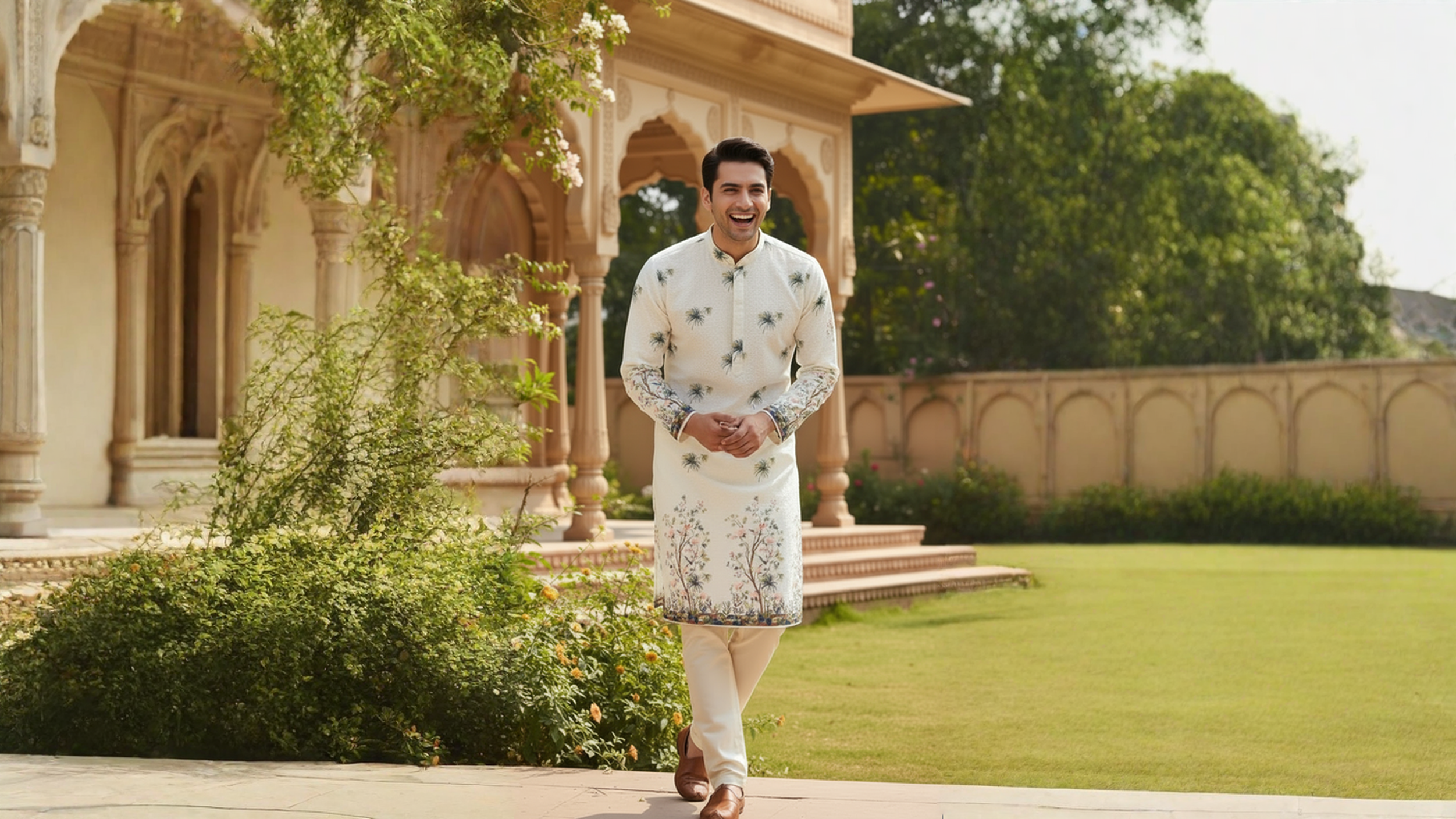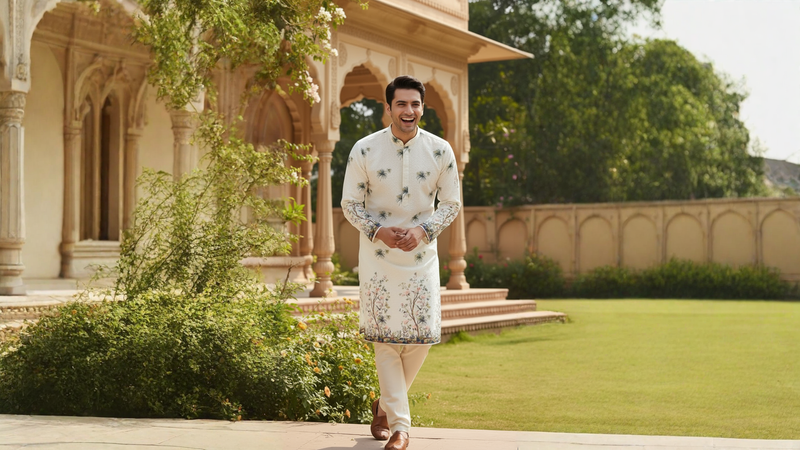Indian ethnic menswear is more than just clothing—it’s a living testament to thousands of years of cultural evolution, artistic expression, and regional diversity. From the royal courts of ancient kingdoms to modern wedding celebrations across the globe, these garments carry stories of tradition, craftsmanship, and identity that continue to captivate the world.
Ancient Roots: Where It All Began
The history of Indian menswear dates back to the Indus Valley Civilization (3300-1300 BCE), where archaeological evidence suggests men wore draped garments made from cotton—a fabric India gifted to the world. The dhoti, one of the oldest forms of Indian attire, has remained virtually unchanged for millennia, representing continuity in an ever-changing world.
Ancient texts like the Vedas and epics such as the Mahabharata and Ramayana describe elaborate clothing styles worn by kings, warriors, and common people alike. These weren’t merely functional garments; they were symbols of status, profession, and regional identity.
The Mughal Influence: A Golden Era of Elegance
The arrival of the Mughal Empire in the 16th century transformed Indian menswear forever. Persian aesthetics merged with Indian craftsmanship to create some of the most iconic pieces we cherish today.
The Sherwani, perhaps the most recognizable piece of Indian formal menswear, evolved during this period. Originally a court dress worn by nobility, it combined the elegance of Persian robes with Indian embroidery techniques. The structured silhouette, intricate embellishments, and regal bearing made it the ultimate symbol of sophistication.
The Achkan and Bandhgala also emerged from this fusion, offering variations that would later become staples of Indian formal wear. The Bandhgala, also known as the Jodhpuri suit, gained particular prominence in the princely state of Jodhpur, where Maharaja Pratap Singh commissioned a shorter, more practical version for polo matches—a perfect blend of functionality and royal elegance.
Regional Diversity: A Tapestry of Traditions
India’s vast geography created distinct regional styles, each reflecting local climate, culture, and traditions:
North India gave us the Kurta Pajama—comfortable, versatile, and timeless. From simple cotton versions for daily wear to heavily embroidered silk pieces for celebrations, the kurta became the backbone of Indian menswear.
South India maintained the tradition of the Veshti (dhoti) and Angavastram (upper cloth), often paired with the elegant Jubba—a long, flowing garment perfect for tropical climates.
Western India, particularly Rajasthan and Gujarat, contributed vibrant colors, mirror work, and the iconic Jodhpuri suit that would eventually gain international recognition.
Eastern India brought us the sophisticated Bengali style, where the dhoti is paired with a kurta or traditional shirt, reflecting the region’s intellectual and artistic heritage.
The Colonial Era and Beyond
British colonial rule introduced Western tailoring techniques to India, but rather than replacing traditional wear, this led to innovative fusion styles. The Indo-Western concept—blending Indian aesthetics with Western cuts—began during this period and continues to evolve today.
Post-independence, Indian ethnic menswear experienced a renaissance. Leaders like Jawaharlal Nehru popularized the Nehru jacket, a sleek, modern interpretation of traditional Indian wear that gained international acclaim and was adopted by fashion icons worldwide.
Craftsmanship: The Soul of Indian Ethnic Wear
What truly sets Indian ethnic menswear apart is the extraordinary craftsmanship passed down through generations:
Embroidery techniques like Zardozi (metallic thread work), Chikankari (delicate white embroidery), and Phulkari (vibrant floral patterns) transform fabric into wearable art.
Handloom traditions across India produce textiles with unique textures and patterns—from Banarasi silk to Khadi cotton, each fabric tells its own story.
Block printing, tie-dye (Bandhani), and hand-painting techniques add layers of visual interest and cultural significance to garments.
Modern Revival: Tradition Meets Contemporary Style
Today’s Indian ethnic menswear represents an exciting intersection of heritage and innovation. Designers and manufacturers are reimagining traditional pieces for modern lifestyles:
-
Slim-fit kurtas offer contemporary silhouettes while maintaining traditional aesthetics
-
Indo-Western fusion pieces combine kurta tops with trousers or jeans
-
Experimental fabrics bring comfort and easy maintenance to traditional designs
-
Minimalist approaches appeal to younger generations seeking understated elegance
The global Indian diaspora has also fueled international interest in ethnic menswear. From weddings in California to Diwali celebrations in London, these garments connect people to their roots while making bold fashion statements.
The Nayaab Ethnics Commitment
At Nayaab Ethnics, we honor this rich heritage by combining traditional craftsmanship with modern manufacturing excellence. Our in-house production ensures that every piece maintains the quality and attention to detail that Indian ethnic wear deserves, while our designs speak to both tradition-conscious customers and style-forward individuals.
Whether you’re choosing a classic Sherwani for your wedding, a versatile Kurta for festive occasions, or exploring our upcoming Jodhpuri and Indo-Western collections, you’re not just wearing clothing—you’re carrying forward centuries of cultural heritage.
Conclusion
The history of Indian ethnic menswear is a journey through time, geography, and artistic expression. Each garment type, embroidery technique, and fabric choice represents decisions made by countless artisans, wearers, and communities over millennia. As we move forward, preserving this heritage while adapting to contemporary needs ensures that these magnificent traditions continue to thrive for generations to come.
Ready to be part of this timeless tradition? Explore our collections and discover pieces that connect you to India’s rich sartorial heritage.
At Nayaab Ethnics, we believe that understanding the history behind what you wear makes every occasion more meaningful. Follow our blog for more insights into Indian ethnic fashion, styling tips, and the stories behind our collections.

